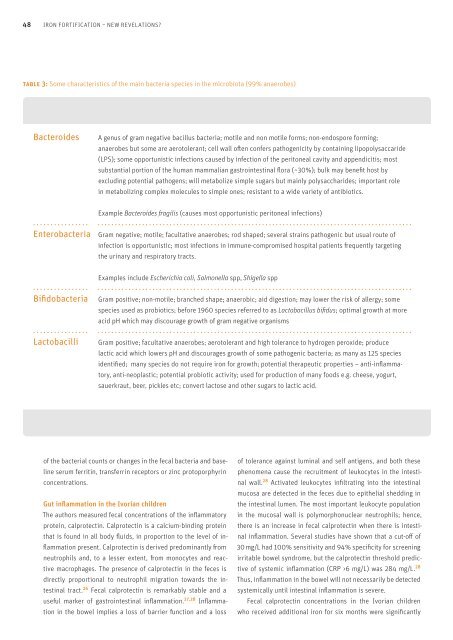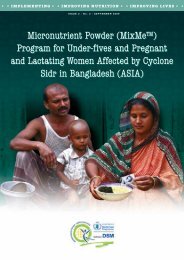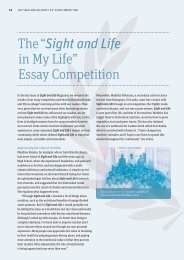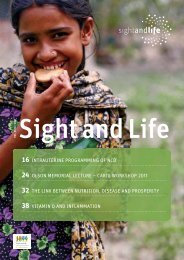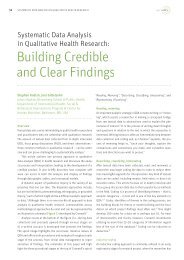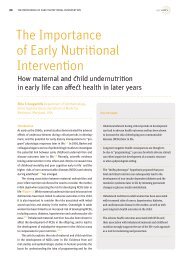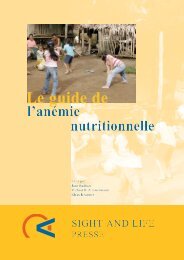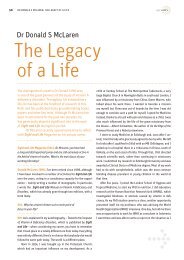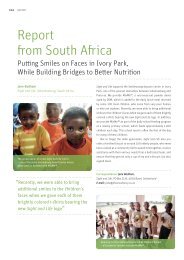Sight and Life Magazine 1/2011
Sight and Life Magazine 1/2011
Sight and Life Magazine 1/2011
You also want an ePaper? Increase the reach of your titles
YUMPU automatically turns print PDFs into web optimized ePapers that Google loves.
48 IRON FORTIFICATION – NEW REVELATIONS?table 3: Some characteristics of the main bacteria species in the microbiota (99% anaerobes)BacteroidesA genus of gram negative bacillus bacteria; motile <strong>and</strong> non motile forms; non-endospore forming;anaerobes but some are aerotolerant; cell wall often confers pathogenicity by containing lipopolysaccaride(LPS); some opportunistic infections caused by infection of the peritoneal cavity <strong>and</strong> appendicitis; mostsubstantial portion of the human mammalian gastrointestinal flora (~30%); bulk may benefit host byexcluding potential pathogens; will metabolize simple sugars but mainly polysaccharides; important rolein metabolizing complex molecules to simple ones; resistant to a wide variety of antibiotics.Example Bacteroides fragilis (causes most opportunistic peritoneal infections)EnterobacteriaGram negative; motile; facultative anaerobes; rod shaped; several strains pathogenic but usual route ofinfection is opportunistic; most infections in immune-compromised hospital patients frequently targetingthe urinary <strong>and</strong> respiratory tracts.Examples include Escherichia coli, Salmonella spp, Shigella sppBifidobacteriaLactobacilliGram positive; non-motile; branched shape; anaerobic; aid digestion; may lower the risk of allergy; somespecies used as probiotics; before 1960 species referred to as Lactobacillus bifidus; optimal growth at moreacid pH which may discourage growth of gram negative organismsGram positive; facultative anaerobes; aerotolerant <strong>and</strong> high tolerance to hydrogen peroxide; producelactic acid which lowers pH <strong>and</strong> discourages growth of some pathogenic bacteria; as many as 125 speciesidentified; many species do not require iron for growth; potential therapeutic properties – anti-inflammatory,anti-neoplastic; potential probiotic activity; used for production of many foods e.g. cheese, yogurt,sauerkraut, beer, pickles etc; convert lactose <strong>and</strong> other sugars to lactic acid.of the bacterial counts or changes in the fecal bacteria <strong>and</strong> baselineserum ferritin, transferrin receptors or zinc protoporphyrinconcentrations.Gut inflammation in the Ivorian childrenThe authors measured fecal concentrations of the inflammatoryprotein, calprotectin. Calprotectin is a calcium-binding proteinthat is found in all body fluids, in proportion to the level of inflammationpresent. Calprotectin is derived predominantly fromneutrophils <strong>and</strong>, to a lesser extent, from monocytes <strong>and</strong> reactivemacrophages. The presence of calprotectin in the feces isdirectly proportional to neutrophil migration towards the intestinaltract. 26 Fecal calprotectin is remarkably stable <strong>and</strong> auseful marker of gastrointestinal inflammation. 27,28 Inflammationin the bowel implies a loss of barrier function <strong>and</strong> a lossof tolerance against luminal <strong>and</strong> self antigens, <strong>and</strong> both thesephenomena cause the recruitment of leukocytes in the intestinalwall. 28 Activated leukocytes infiltrating into the intestinalmucosa are detected in the feces due to epithelial shedding inthe intestinal lumen. The most important leukocyte populationin the mucosal wall is polymorphonuclear neutrophils; hence,there is an increase in fecal calprotectin when there is intestinalinflammation. Several studies have shown that a cut-off of30 mg/L had 100% sensitivity <strong>and</strong> 94% specificity for screeningirritable bowel syndrome, but the calprotectin threshold predictiveof systemic inflammation (CRP >6 mg/L) was 284 mg/L. 28Thus, inflammation in the bowel will not necessarily be detectedsystemically until intestinal inflammation is severe.Fecal calprotectin concentrations in the Ivorian childrenwho received additional iron for six months were significantly


